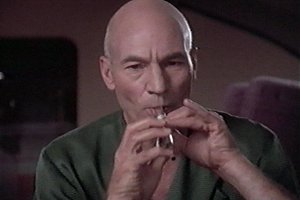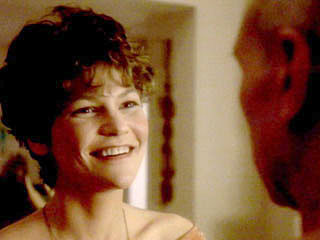Blog #22 by Amy Ulen,
English Teacher, Tumwater High SchoolI keep begging all of you to
send in a story about how Star Trek has influenced your life, and the few I have received are amazing. Many of the blog articles to date are about profound issues and effects that
Star Trek has had on peoples lives, so I’m going to lighten it up a bit and describe how
Star Trek turned me into a rock star for a day and an instant celebrity at my school!
Excerpt from A Day on the Set: A Fan's Ultimate Star Trek
first printed on startrek.com April 29, 2004 My trek to the stars began with a radio contest on KZOK-FM in Seattle. The contest ran for three weeks with two finalists picked each week. Unfortunately, I didn’t hear about the contest until the second week, so I only had two shots at qualifying. My first attempt was a miserable failure when I tried calling in on my cell phone from school. Although I knew the answers to the trivia contest, I couldn’t get through the phone lines. I made a decision that morning that I was going to take the following Thursday morning off work so that I could use my landline at home to qualify. Wednesday night rolled around and I sat poised with a notepad and watched “Hatchery.” Four pages of notes later, I was ready for the contest. Again, I called and couldn’t get through. The question was “What was the Starfleet regulation that allowed Phlox to relieve Archer of command?” The answer was Regulation 104, Section C, but the line was busy. While I frantically hit redial, at least six callers gave the wrong answer. When I finally made it through, I had to wait for two more people to attempt the answer. I was in agony as one woman said “104, section…3,” and the next caller said “section 5.” Finally, my line was selected and I shouted the answer. At that moment, my incredible journey began.
 Those of us who qualified had to submit a photo and brief essay to KZOK. My essay read, “As a high school English teacher, I have my students compose a list of 50 things they want to do, see, or accomplish before they die as a journal entry. I always share my list with the kids, and they laugh when they see ‘Be on an episode of Star Trek’ as one of my goals. They don’t believe that my goal is attainable therefore shouldn’t be on the list. I want to prove to them that as outrageous as a dream may seem, anything is possible! You can help me teach this valuable life lesson by voting for me.” After submitting my contest entries, I went to school and straight to my principal. As I was one of the last qualifiers, the final web voting was opening that afternoon. I told my principal all about the contest and asked him if I could make an announcement over the intercom. He agreed! As soon as voting opened, students all over the school logged on and voted for me. After being announced the winner the following morning, I instantly earned celebrity status at school. As I walked across the commons toward the Performing Arts Center to teach my acting classes, kids were hanging out the windows yelling their congratulations and that they had voted for me. Over a month later, the kids are still talking about it and eagerly anticipating the episode.
Those of us who qualified had to submit a photo and brief essay to KZOK. My essay read, “As a high school English teacher, I have my students compose a list of 50 things they want to do, see, or accomplish before they die as a journal entry. I always share my list with the kids, and they laugh when they see ‘Be on an episode of Star Trek’ as one of my goals. They don’t believe that my goal is attainable therefore shouldn’t be on the list. I want to prove to them that as outrageous as a dream may seem, anything is possible! You can help me teach this valuable life lesson by voting for me.” After submitting my contest entries, I went to school and straight to my principal. As I was one of the last qualifiers, the final web voting was opening that afternoon. I told my principal all about the contest and asked him if I could make an announcement over the intercom. He agreed! As soon as voting opened, students all over the school logged on and voted for me. After being announced the winner the following morning, I instantly earned celebrity status at school. As I walked across the commons toward the Performing Arts Center to teach my acting classes, kids were hanging out the windows yelling their congratulations and that they had voted for me. Over a month later, the kids are still talking about it and eagerly anticipating the episode.

What I didn’t write about in the
startrek.com article was the depth of student involvement in helping me win the contest and achieve my dream. After my principal made the initial announcement inviting students to vote for me in the contest, nearly every computer in the school was used for voting. The radio station used cookies so that each computer could only be used once, so by the time 4th period rolled around, the kids could no longer vote. As usual, the tech-savvy kids came up with the solution to erase the cookies so more kids could vote. I didn’t want to take the chance of being disqualified, so I told them to wait and vote at home. My kids did more than that…much more! They immediately started sending off e-mail, sending text messages, and calling everyone they knew to encourage them to vote for me. Their campaign was so successful, that I won by a landslide. Hundreds of votes separated me from the rest of the contestants, and I only had qualified that morning!

The following morning the school was abuzz with anticipation while we waited for the contest winner to be announced. At the appointed time, my 3rd period class and I paused our lesson to listen to the radio. As I stood in front of the room, a bundle of excited nerves, I looked at my students who were ALL giving the Vulcan salute! To this day—two years later—that moment still brings a tear to my eye. Those kids genuinely wanted me to achieve my dream. They didn’t get everyone they knew to vote for me so they could earn extra credit or some other form of personal gain, they gave from the goodness of their hearts, and I will always admire them for that. Even had I not won the contest, I considered myself blessed in that moment to be teaching such a fine group of human beings. Yet, I did win, and the room erupted with shouts of celebration. My lesson plan for the period was forgotten as the kids swarmed me with hugs and high-fives. Students from around the school ran to my room to let me know I won and the phone started ringing off the hook. It was an incredible moment that I will never forget.

Many of those same kids tuned in to
Enterprise for the first time on May 26, 2004. They had heard all of the stories about my day on the set and wanted to see my television debut. Several of them became
Star Trek fans that night, which gave us a lot to talk about when they were hanging out in my room after school. Most of the kids who voted for me that day graduated last year, but the freshmen will be seniors this year, and we are looking forward to exploring the world of Sci-Fi in my new English elective!
 Star Trek
Star Trek has influenced my life in so many ways, but this experience encapsulated it all.
Star Trek is about achieving impossible dreams. It is about using technology to seek out and enhance life. It is about community.
Star Trek is about a room full of kids who will forever “live long and prosper” in my heart!




















